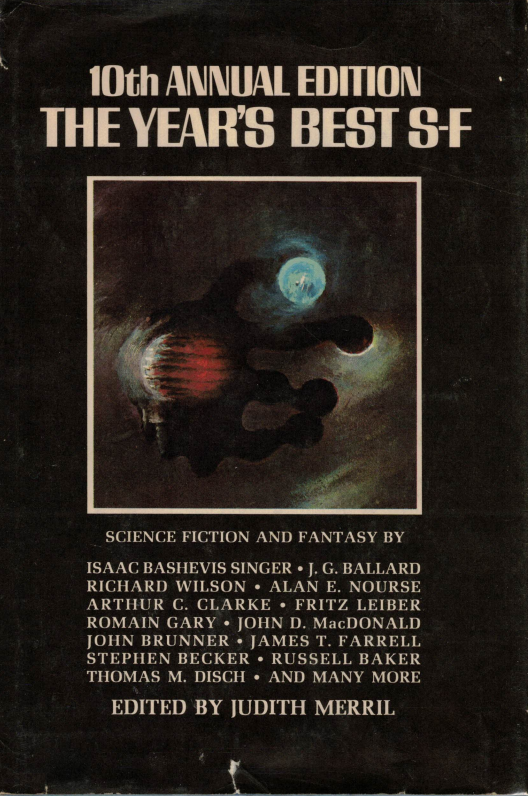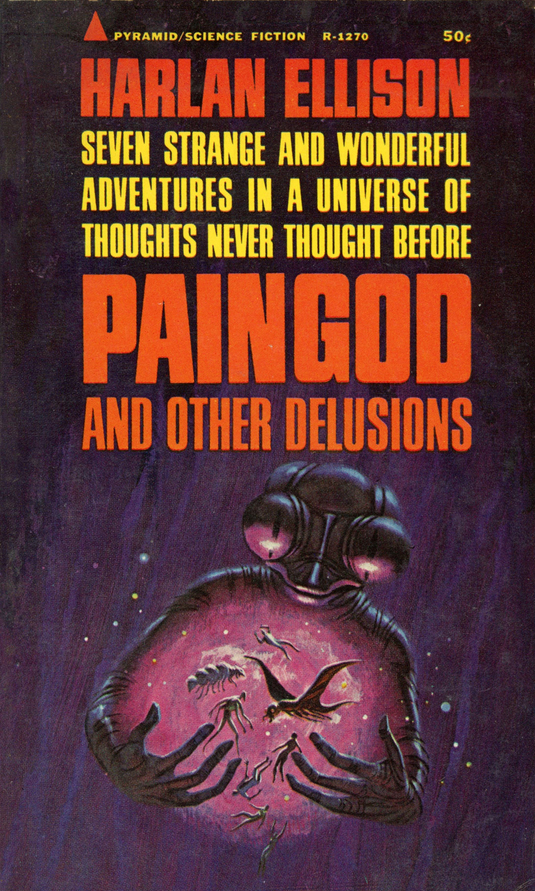
by Erica Frank
Introduction
After looking over Playboy in January and finding Vonnegut's gem of a story, I decided to check out the next few issues. This time I skipped all the political commentary (which is mostly "money is good and women should wear fewer clothes") and focused on the stories and articles potentially of interest to science fiction fans.

Cover of March 1968's Playboy. I found this the least-boring cover of the set – the only one that looks like she's having fun.
I read everything that looked remotely like it might be a science fiction story, even though some of them were a stretch. I also looked at the science-related articles. There are quite a few of them, since this covers a five-month period.
A Day in the Life of…, by Ralph Schoenstein (February)
The full title of this story is "A Day in the Life of President George Romney—Or Robert Kennedy, Richard Nixon, Ronald Reagan, Martin Luther King, Charles Percy, Hubert Humphrey, Nelson Rockefeller, Lurleen and George Wallace." It's a satire inspired by Jim Bishop's A Day in the Life of President Johnson, speculating about the biographies of other potential presidents. I had hoped this involved some kind of parallel universe setting, or time travel… but no. This is just mild political commentary, a few paragraphs of satirical character study on each.
Romney awakens at 5 a.m. and scowls at his wife for addressing him by his first name. Kennedy leaps from his bed and cartwheels into the bathroom. Nixon polls his public to find out if he should get out of bed in the morning. Reagan is refraining from sex for the duration of his presidency to avoid the risk of marks. King never smiles and never argues. Humphrey worships LBJ and calls him "Big Daddy."
As satire: 3 stars. As science fiction: 1 star–there's some vague hint of multiple universes, but that's all.
Hat Trick, by Robert Coover (February)
Certainly interesting. A magician performs a hat trick – pulling bunnies, doves, another hat, and eventually, a whole assistant out of his hat. And then the story turns dark. This had some surprising twists and a disturbing ending.
4 stars; this one will stick with me.
The Chronicle of the 656th, by George Byram (March)
The set-up: a former student brings his professor a locked box, found buried under a house he'd purchased. The box contains Civil-War-era documents and objects – and a notebook dated 1944. After establishing that this was not a hoax, he'd read through the notebook: an entire army combat team had vanished from their WWII training area and found themselves in 1864. They help win a major Civil War battle, although several of the team members are conflicted – their families and ancestors are from the South.
The writing is good, but the story is not. Everyone dies, so there's no time paradox to address. It reads like normal fiction, not like a series of diary entries. I guessed the big secret as soon as they established what happened. (Secret atomic bomb testing sent them back in time! How shocking!) This must be what the mundanes think science fiction is supposed to be.
2 stars. Unless you enjoy war stories, in which case, it may be 3.
The Origin of Everything, by Italo Calvino (March)
This "story" is two vignettes that take place at the beginning of the universe – one before the Big Bang (or, mostly before), and one a bit after. They are both whimsical explorations of the idea of "people" in places where people obviously cannot exist.

The art by George Suyeoka nicely captures the feel of the story.
There's a surreal conjunction the everyday and the cosmic: Mrs. Ph(i)Nko taking Mr. De XuaeauX to bed, but since they are all in a single point before the expansion of the universe,
…"it isn't a question of going to bed, but of being there, because anybody in the point is also in the bed. Consequently, it was inevitable that she should be in bed also with each of us.
After the creation of the universe, all of the residents of the point hope to find Mrs. Ph(i)Nko again, but alas, she cannot be found; only the memory of her love for them all survives.
In the second vignette, astral children play marbles with hydrogen atoms; one child has stolen all the new atoms, and one of his companions then tricks him with fake atoms made of junk.
4 stars; this was delightful.
The Bizarre Beauties of "Barbarella" (March)
This is a pictorial review of the movie that's coming out later this year, based on the French comic, "The erotic space adventures of Barbarella." I'm not familiar with the comic, but I gather it has
- Beautiful women
- Wearing very few clothes
- Having sex
- In space

The Black Queen enjoys a dream interlude with the angel Pygar, whom she's forced to obey her will.

Fashion of the future on the planet Lythion

Barbarella rescues Pygar, and then Pygar rescues Barbarella.
I'm not rating this, but I am looking forward to the movie when it comes out.
Bucking the scientific Establishment, by Theodore J. Gordon (April)
This is a nonfiction article about innovative scientists who were initially faced with derision and insults, and were later proved to be correct. …Or rather: this is an article about innovative historical scientists, and a handful of current scientists whose theories are still considered more in the category of "crackpot" than "fact," which the author would like you to believe are very plausible, as shown by the fact that several other scientists used to be considered crackpots but are now lauded as groundbreakers in their fields.
Author seems to have skipped over the thousands of so-called scientists who were widely believed to be crackpots and later were still believed to be crackpots.
2 stars. Reasonably entertaining writing; good facts; bad science.
Papa's Planet, by William F. Nolan (April)
This is short and I wish it were forgettable. Fortunately, it's incoherent enough that most of the details will fade with time. Philip, our protagonist, is Cecile's fourth husband; her father recently died and left him the deed to a planet. The story is obviously not meant to be taken seriously ("Five million miles out from Mars, we turned sharp left and there it was: Papa's Planet"), and while it's obviously science fiction–the planet is inhabited by nothing but Hemmingway clones–there's not really any actual story here. (Is this what the mundanes think science fiction is?)
2 stars. It's not anything like good but it's not overtly bad enough for me to rank it at 1 star.
The Annex, by John D. MacDonald (May)
I had hopes for this one. It started out interesting: a nurse tending an unconscious patient, discovering he's dislodged his IV needle. Then it shifts perspective entirely: Mr. Dave Davis visits a huge, strange building, in the process of being torn down while its residents refuse to leave. There are hints that he's on some kind of assignment from an agency; he tries not to reveal exactly why he's visiting or how he got access. His guide, Mrs. Dorn, refuses to let him find his own way, insisting he'd just get lost. (It is clear that yes, he would quickly get lost.) When they reach his destination–
The story loses focus. It gets a bit surreal; while I generally enjoy surreal–see my notes about the Calvino story above–this lacks the whimsy or allure that would allow it to be more than somewhat nonsensical. Then the story shifts back to the nursing ward, where Silvia Dorn is a nurse, her beloved Dave is being kept alive by machines, and the reader is obviously meant to draw meaning from these details in a way that eluded me.
3 stars, I suppose–I can tell there's a decent story here even if it seems to want a set of assumptions I don't share.
Henne Fire, by Isaac Bashevis Singer (May)
This is told folktale-style, a story of Jewish fantasy (of a sort) rather than classic science fiction. Henne Fire is a terrible woman–she has been so awful, all her life, that she basically became a demon. Or perhaps she was born as one. She was nasty to everybody. Eventually, she became prone to random attacks of hellfire–her clothing would catch fire, or little flames would start around her. She could not even move into the poorhouse; nobody wanted a boarder who would catch houses on fire. She pleaded with the rabbi to help her, and eventually, the town made her a small brick house–basically a shack made of stone, with a tin roof.

Illustration by Bernard McDonald
The neighbors might've just shunned her after that, but one of her daughters married a rich American and started sending her money. Suddenly everyone wanted to befriend her. (This did not make her a nicer person.) One day people noticed that Henne hadn't been around for a few days, and they found her remains at home–a burnt skeleton, sitting in a chair with no mark of fire on it.
3 stars; entertaining enough.
The Dead Astronaut, by J. G. Ballard (May)
After the space age is decades past–shut down after a bloody history of orbital accidents–a married couple awaits the crash landing of their friend who died 20 years ago, so they can gather his remains.

Charle Schorre's illustration is eye-catching and does not actually capture the tone of this semi-post-apocalyptic story.
I enjoyed this story, although it is not a happy tale and it does not end well for anyone. I especially enjoyed: Mrs. Groves had been (was still?) in love with the astronaut, and her husband does not seem to have been jealous–mostly amused, and a bit concerned for her. I did not enjoy: The revelation of the ominous secret (a bit too predictable), and the final moments where the husband says, "I never asked you–" and then looks at her, and realizes he has his answer.
What that answer was, what the question was, I do not know. This was obviously written for men of a certain class, of a certain culture, who would understand the unspoken words. I can recognize the poignancy of the ending but I don't know what actually happened.
3 stars. If I'd been part of the intended audience, it probably would be 4.
The Snooping Machine, by Alan Westin (May)
Another nonfiction piece, positing a cashless, computer-data-driven society by 1975. It mentions that computer tape is so efficient a storage medium that one could hold 2000 pages of data for each of America's two hundred million citizens in a single room, on as few as a hundred reels of tape.
It discusses some history of government data-gathering, which includes both "big brother" hysteria and a pressing need for accurate data on which to base decisions. (Which regions need better school funding? Which areas might need new roads?) Government officials have admitted it may be impossible to separate personal identity details from the data they need, and that sorting out the conflicting interests in privacy and data is an ongoing problem.
3 stars. A nice overview of data technology and both the problems and possibilities it brings, but a bit pedantic in approach.
The Man from Not-Yet, by John Sladek (June)
Epistolary fiction, told through letters. Two friends in 1772 discuss an incident some ten years past, in which they had a visitor who claimed to be from the future. He was questioned by Samuel Johnson, who asked disparaging questions–"You will want to tell me no doubt of carriages that operate without benefit of horses. Of engines that carry men through the air like birds. Of ships without sails."
The visitor is astounded that he has guessed the future so correctly, but Johnson just scoffs, until the man offers to bring him to the future. They visit his time machine; the two enter the device; after a few moments of silence, it glows and explodes, leaving Dr. Johnson in the wreckage but the traveler gone.
The remaining few letters let the readers know what happened, while the men themselves remain unaware.
3 stars. I have little interest in this kind of historical fiction, and there is almost no point to the story: too much exposition with a "gotcha" twist at the end.
Ghost, by Hoke Norris (June)
The protagonist of this story is a somewhat conservative, ambitious man who has a "ghost" that speaks to him constantly, urging wild and rebellious acts. The ghost was the previous inhabitant of his body, and he cannot get rid of it even though he is now in control. He is also dating the boss's wife's sister (instead of the girl he loves). He wants the money and status that comes with the high-class connections but he also wants the comfort and joy he finds with Marie; he is caught between these two issues (with the ghost constantly berating him for his ambition) until Marie turns up pregnant.
They have a fight, he goes for a walk, and everything changes.
4 stars–this one will (heh) haunt me.
Conclusion
Playboy is about on par with most science fiction magazines for quality, and better than some… if you can accept that it has only one to three pieces per issue that are relevant to science fiction fans. Although the stories are okay, with some much better than that, many of the best-written stories have dark themes or unhappy endings or both. It seems the average Playboy reader is not expected to be interested in stories of otherworldly exploration or how technology might solve our problems, but how people with psychic powers or spaceships are just as likely to be miserable as the average person today. It's heavy on pedantic verbosity and all rather depressing.
If you also like the libertarian politics, there is more entertainment per issue, and of course, if your interests include pictures of young women with their shirts off, it has quite a bit to offer.

![[June 18, 1968] I Just Read It for the Stories (February-June 1968 <i>Playboy</i>)](https://galacticjourney.org/wp-content/uploads/2023/06/680618_PBCvrMarch-672x372.png)

![[December 24, 1965] Gallimaufry <i>du Saison</i>(<i>The Year's best Science Fiction</i> and <i>Paingod and Other Delusions</i>)](https://galacticjourney.org/wp-content/uploads/2020/12/651224covers-672x372.jpg)







